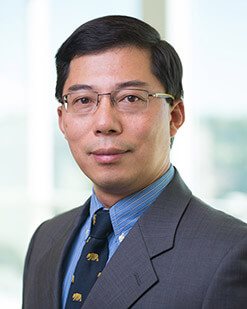Shaodong Dai, PhD

Shaodong Dai, PhD, is a researcher at National Jewish Health. Dr. Dai is in the Department of Immunology and Genomic Medicine.
Special Interests
Research Interests
Metal ions are essential nutrients in all forms of life. Despite their important roles, metals can be toxic and elicit different kinds of immune responses, causing diseases. Chronic beryllium disease is a fibrotic lung disorder caused by beryllium exposure, while nickel ion is the dominant allergen for contact dermatitis.
Our major goal is to understand the mechanisms of the metal containing ligands for alpha/beta TCRs from metal reactive human T cells. Using structural biology we will be able to discern the respective rule for metal binding and find potent compounds to inhibit metal binding, thus abrogating T cell responses. We are also interested in the molecular basis of metal induced autoimmunity.
Recently we observed metal ions directly attenuate the binding affinity between TCR and pMHC interaction. Our goal is to understand how the metal ions attenuate the TCR/pMHC binding affinity and what effects they have on T cells activation. The results can help to elucidate the molecular basis for some autoimmunity caused by metals. We are interested in redox signaling in chloroplast and T Cells.
We are studying a unique iron-sulfur enzyme, ferredoxin: thioredoxin reductase, containing both a catalytic [4Fe-4S] cluster and a redox active disulfide. The overall objective of this proposal is to decipher the mechanisms of reduction of disulfide catalyzed by iron sulfur cluster and thiol-disulfide exchange reactions in ferredoxin /thioredoxin system. Redox signaling in apoptosis involves the oxidation and reduction of cysteine residues in critical thiol proteins. Changes in the structure and activity of these proteins can initiate cell responses, or modify the response of cells to other signals.
My proposed research focuses on the regulatory mechanisms of apoptosis signal-regulating kinase 1 (ASK1) mediated T cell apoptosis. ASK1 is a member of the mitogen-activated protein kinase kinase kinase (MAP3K) family, which activates both the SEK1-JNK and MKK3/6-p38 MAP signaling cascades and constitutes a pivotal signaling pathway in cytokine- and stress-induced apoptosis. This signaling pathway mediates a variety of cellular events, including cell proliferation, differentiation, and death.
Education
Education
- 1998
- Uppsala Biomedical Centre, Sweden, PhD
Fellowship
- 2001
- Purdue University (W. Lafayette, IN), Postdoctoral Fellow
Awards & Recognition
2010-2014: Boettcher investigator
2011-2014: NIH KL2 Research Scholar
2014: First Place Winner, CCTSI Symposium poster session in the category of Junior Investigator
2014: Best Abstract Prize, European Academy of Allergy and Clinical Immunology Congress
Section editor of protein structure in chemical sciences for Amino acids
2007: Speaker, 13th International Congress of Immunology
2007: Young Scientist Travel Grant, 13th International Congress of Immunology
2006: Speaker, American Crystallographic Association meeting
2001: Travel Stipend from BioCARS Time Resolved Crystallography Workshop,
2000: Congress award from American Crystallographic Association for ACA meeting
1998: Travel award from Wallenberg’s foundation
1998: Travel grant from European Crystallography Meeting -18 Organizing Committee
1998: Travel grant from Organizing Committee of the Summer School "Structure and Function of Metalloproteins"
1996: Travel grant for young scientists in Swedish University of Agricultural Sciences
1996: Chinese Academy of Sciences travel grant for overseas scholars
Professional Memberships
AAI
ACA
Publications
Cell. 2014 Jul 3;158(1):132-42. doi: 10.1016/j.cell.2014.04.048.Structural basis of chronic beryllium disease: linking allergic hypersensitivity and autoimmunity.Clayton GM, Wang Y, Crawford F, Novikov A, Wimberly BT, Kieft JS, Falta MT, Bowerman NA, Marrack P, Fontenot AP, Dai S, Kappler JW.
Curr Opin Immunol. 2013 Dec;25(6):775-80. doi: 10.1016/j.coi.2013.07.012. Epub 2013 Aug 23.T cell recognition of beryllium.Dai S, Falta MT, Bowerman NA, McKee AS, Fontenot AP.
Immunol Res. 2013 Mar;55(1-3):83-90. doi: 10.1007/s12026-012-8351-1. Structural basis of metal hypersensitivity. Wang Y, Dai S.
Proc Natl Acad Sci U S A. 2012 Nov 6;109(45):18517-22. doi: 10.1073/pnas.1215928109. Epub 2012 Oct 22.T-cell receptor (TCR) interaction with peptides that mimic nickel offers insight into nickel contact allergy. Yin L, Crawford F, Marrack P, Kappler JW, Dai S.
Proc Natl Acad Sci U S A. 2010 Apr 20;107(16):7425-30. doi: 10.1073/pnas.1001772107. Epub 2010 Mar 31.Crystal structure of HLA-DP2 and implications for chronic beryllium disease. Dai S, Murphy GA, Crawford F, Mack DG, Falta MT, Marrack P, Kappler JW, Fontenot AP.
Academic Affiliations
Associate Professor, Department of Immunology and Microbiology, University of Colorado Denver
Teaching & Professional Positions
2014-Present: Associate Professor, Department of Biomedical Research, National Jewish Health
2008-2014: Assistant Professor, Integrated Department of Immunology, National Jewish Health
2001-2008: Instructor, Howard Hughes Medical Institute, Integrated Department of Immunology, National Jewish Health
1999- 2001: Postdoctoral Research Associate, Department of Biological Sciences, Lilly Hall of Life Sciences, Purdue University (West Lafayette, IN)
1993- 1999: Research Assistant, Department of Molecular Biology, Uppsala Biomedical Centre (Uppsala, Sweden)
